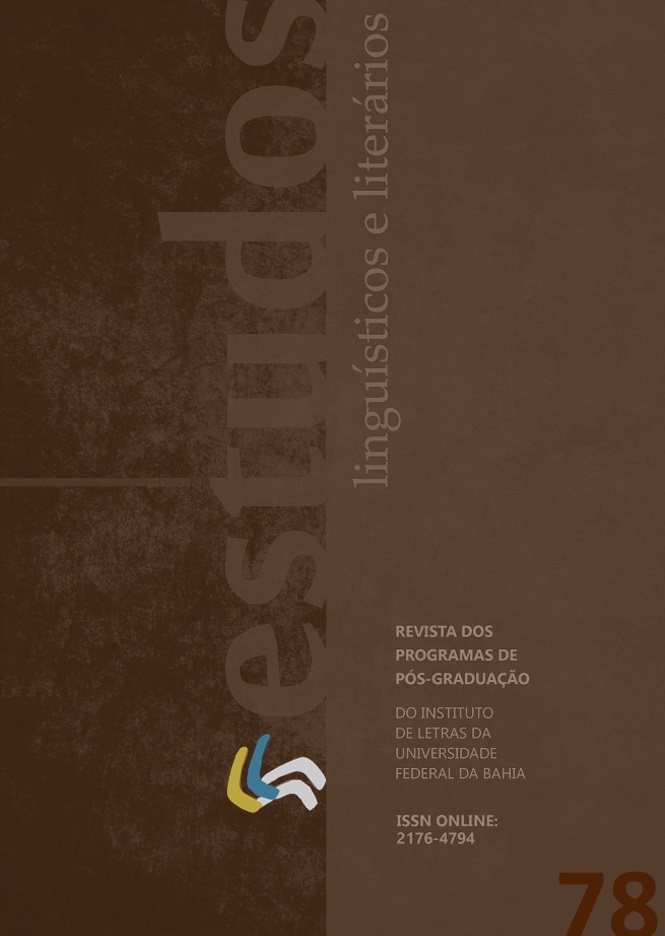AS INTERFACES ENTRE LINGUAGEM E EMOÇÃO:
O CASO DAS EMOÇÕES MISTAS
DOI:
https://doi.org/10.9771/ell.v0i78.55523Palabras clave:
Linguagem; Emoções Mistas; Cognição SocialResumen
O presente trabalho aborda as emoções mistas e sua relação com a linguagem. O objetivo principal é analisar as características de trabalhos realizados sobre o fenômeno e as questões linguísticas relacionadas a ele. Uma emoção mista é um estado emocional que compreende duas emoções diferentes, como se sentir feliz e triste ao mesmo tempo. A perspectiva teórica adotada baseia-se nos trabalhos de Damásio (2018), de Waal (2021), Foolen (2016), Larsen et al. (2001) e Vaccaro et al. (2020). Metodologicamente, realizamos um levantamento bibliográfico acerca das pesquisas sobre emoções mistas nos últimos 30 anos. Os resultados indicam que: há diferentes estímulos e tarefas utilizados nas pesquisas; o intervalo etário mais pesquisado é entre os 4 e 11 anos; a combinação emocional mais investigada é “feliz e triste”; as palavras “feliz” e “triste” são mais frequentes do que blends linguísticos.
Descargas
Citas
BERNARDINO, Leonardo G.; FIGUEIREDO, Thuany T. Percepção subjetiva de tempo de palavras com conteúdo emocional. Letrônica, 16, n. 1, p. e44333-e44333, 2023.
BROOKS, Jeffrey A.; SHABLACK, Holly; GENDRON, Maria; SAPTUTE, Ajay B.; PARRISH, Michael H.; LINDQUIST, Kristen A. The role of language in the experience and perception of emotion: a neuroimaging meta-analysis. Social Cognitive and Affective Neuroscience, 12, n. 2, p. 169-183, 2017.
CHOE, Katherine S.; KEIL, Frank C.; BLOOM, Paul. Children's understanding of the Ulysses conflict. Developmental Science, 8, n. 5, p. 387-392, 2005.
DAMÁSIO, António. A estranha ordem das coisas: as origens biológicas dos sentimentos e da cultura. São Paulo: Editora Companhia das Letras, 2018.
DE WAAL, Frans. O último abraço da matriarca: As emoções dos animais e o que elas revelam sobre nós. São Paulo: Editora Schwarcz-Companhia das Letras, 2021.
DONALDSON, Sally K.; WESTERMAN, Michael A. Development of children's understanding of ambivalence and causal theories of emotions. Developmental psychology, 22, n. 5, p. 655, 1986.
FIGUEIREDO, Thuany Teixeira de. Linguagem e Teoria da Mente de segunda ordem: investigando os estados mentais de ignorância e crença falsa. 2018. 184f. Dissertação (Mestrado em Linguística). Instituto de Estudos da Linguagem, Universidade Estadual de Campinas, Campinas, 2018.
FOOLEN, Ad. A relevância da emoção para a linguagem e para a Linguística. In: CAVALCANTE, S. M. S.; MILITÃO, J. A. (orgs.). Emoções: desafios para estudos da linguagem e cognição. Belo Horizonte: PUC Minas, 2016. p. 13-39.
FRANCO, Maria da Glória S. D. E. C; SANTOS, Natalie N. Desenvolvimento da compreensão emocional. Psicologia: Teoria e pesquisa, 31, p. 339-348, 2015.
HARTER, Susan; BUDDIN, Bonnie J. Children's understanding of the simultaneity of two emotions: A five-stage developmental acquisition sequence. Developmental psychology, 23, n. 3, p. 388, 1987.
KAGAN, Jerome. What is emotion?: History, measures, and meanings. Yale: Yale University Press, 2007.
KESTENBAUM, Roberta; GELMAN, Susan A. Preschool children's identification and understanding of mixed emotions. Cognitive Development, 10, n. 3, p. 443-458, 1995.
LARSEN, Jeff T.; MCGRAW, A. Peter; CACIOPPO, John T. Can people feel happy and sad at the same time?. Journal of personality and social psychology, 81, n. 4, p. 684-696, 2001.
LARSEN, Jeff T.; TO, Yen M.; FIREMAN, Gary. Children's understanding and experience of mixed emotions. Psychological Science, 18, n. 2, p. 186-191, 2007.
NÓBREGA, Vitor Augusto; MINUSSI, Rafael Dias. O tratamento da morfologia não-concatenativa pela morfologia distribuída: o caso dos blends fonológicos. Revista Letras, n. 91, p. 158-177, 2015.
ROAZZI, Antonio; DIAS, Maria da Graça B. B.; SILVA, Janaína O. D.; SANTOS, Luciana B. D.; ROAZZI, Maíra M. O que é emoção? Em busca da organização estrutural do conceito de emoção em crianças. Psicologia: Reflexão e Crítica, 24, p. 51-61, 2011.
SMITH, Joshua P.; GLASS, Daniel J.; FIREMAN, Gary. The understanding and experience of mixed emotions in 3–5-year-old children. The Journal of genetic psychology, 176, n. 2, p. 65-81, 2015.
VACCARO, Anthony. G.; KAPLAN, Jonas T.; DAMASIO, António. Bittersweet: the neuroscience of ambivalent affect. Perspectives on Psychological Science, 15, n. 5, p. 1.187-1.199, 2020.
WINTRE, Maxine Gallander; VALLANCE, Denise D. A developmental sequence in the comprehension of emotions: Intensity, multiple emotions, and valence. Developmental psychology, 30, n. 4, p. 509, 1994.
ZAJDEL, Ruth T.; BLOOM, Jill Myerow; FIREMAN, Gary; LARSEN, Jeff T. Children's understanding and experience of mixed emotions: The roles of age, gender, and empathy. The Journal of genetic psychology, 174, n. 5, p. 582-603, 2013.


